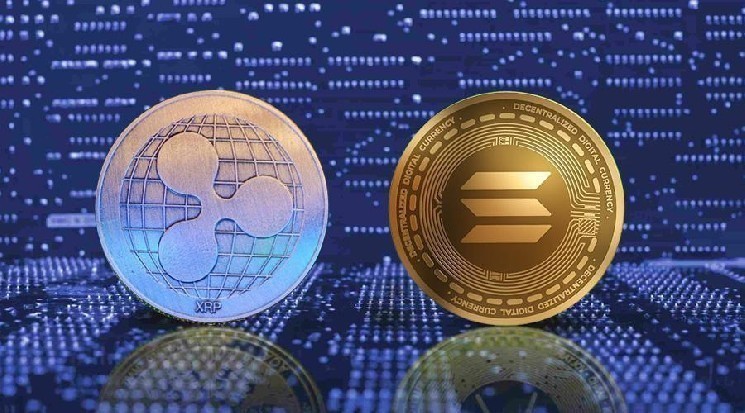XRP and Solana ETFs Shatter Records as Crypto Investment Landscape Evolves
Explosive Growth in Crypto ETF Market Signals New Era for Digital Asset Investment
The cryptocurrency investment landscape is undergoing a profound transformation as specialized exchange-traded funds (ETFs) continue to attract unprecedented capital inflows, signaling growing mainstream acceptance of digital assets beyond Bitcoin. According to detailed analysis from Bloomberg Intelligence Senior Analyst James Seyffart, recently launched XRP and Solana ETFs have demonstrated exceptional market performance, establishing new benchmarks for the industry and potentially reshaping how traditional investors gain exposure to the broader cryptocurrency ecosystem.
In a wide-ranging interview on the Coin Bureau Podcast, Seyffart provided critical insights into the current state of cryptocurrency ETFs and offered forward-looking perspectives on market developments. “The performance has been extraordinarily well for both the XRP and Solana ETFs since their inception,” Seyffart explained to host Nic, highlighting that Bitwise’s Solana ETF and Canary’s XRPC ETF claimed the top two positions for ETF launches in the United States by trading volume this year. This remarkable achievement comes despite considerable volatility in the broader cryptocurrency markets, demonstrating resilient demand for regulated investment vehicles that provide exposure to prominent altcoins.
Record-Breaking Inflows Demonstrate Strong Retail Demand Despite Market Headwinds
The unprecedented success of these specialized cryptocurrency ETFs reveals a significant appetite among retail investors for diversification beyond Bitcoin and Ethereum. Seyffart noted that Canary’s XRPC ETF has maintained consistent daily inflows of approximately $15 million even after its initial launch, which alone attracted an impressive $240 million in capital. This sustained investor interest comes despite challenging market conditions, suggesting that regulated investment vehicles are successfully capturing demand from investors who might otherwise be hesitant to directly purchase cryptocurrencies through exchanges or self-custody solutions.
“What we’re witnessing is compelling evidence of strong retail demand for altcoin exposure through familiar, regulated investment structures,” Seyffart observed during the interview. The analyst emphasized that these investment patterns indicate a maturing market where traditional financial instruments are increasingly bridging the gap between conventional investment portfolios and digital assets. This evolution represents a significant milestone in cryptocurrency’s journey toward broader institutional acceptance and retail adoption, as ETFs provide a familiar framework that aligns with existing investment methodologies while mitigating some of the technical barriers to entry that have historically limited cryptocurrency adoption.
SEC Activity Resumes: Dogecoin and Chainlink ETFs Poised for Imminent Launch
With the Securities and Exchange Commission (SEC) resuming normal operations following a temporary government shutdown, the cryptocurrency ETF landscape is set for further expansion. Seyffart confirmed that the next wave of digital asset ETFs is already in progress, with Dogecoin and Chainlink products positioned as the next significant market entrants. According to the Bloomberg analyst, Grayscale’s existing Chainlink Trust is anticipated to complete its conversion to an ETF structure by December 2, while Bitwise’s pioneering Dogecoin ETF is scheduled for launch on November 26, potentially opening these assets to an entirely new category of investors.
The analyst also highlighted BlackRock’s distinctive approach with its application for an Ethereum ETF that includes staking functionality, describing it as a “unique strategy” with potentially significant tax implications for investors. This innovative approach demonstrates how traditional financial institutions are not merely replicating existing cryptocurrency investment strategies but are developing sophisticated products that leverage the unique capabilities of blockchain technology. “The introduction of staking functionality within an ETF wrapper represents a new frontier for regulated crypto investment products,” Seyffart explained, suggesting that such innovations could further differentiate cryptocurrency ETFs from traditional investment vehicles and potentially offer enhanced yield opportunities for investors.
Altcoin Season Evolution: From Direct Token Investment to Structured Products
When addressing the current state of the altcoin market, Seyffart proposed a nuanced perspective that challenges conventional market narratives. Rather than anticipating a future “altcoin season” characterized by dramatic price appreciation across smaller cryptocurrencies, he suggested that such a phenomenon may have already manifested—albeit through different investment vehicles than direct token purchases. “What’s interesting is that investor interest isn’t flowing directly into altcoins themselves, but rather into Digital Asset Trusts and cryptocurrency mining companies,” Seyffart observed, indicating a maturation in how market participants seek exposure to the sector.
This evolution reflects broader market sophistication, with investors now having access to structured financial products like options on Bitcoin ETFs that can provide leverage or enhanced returns without necessitating direct altcoin investments. “As the market matures, we’re seeing a fundamental shift in how investors seek high-beta exposure to cryptocurrency price movements,” Seyffart elaborated. “Where previously altcoins served as the primary vehicle for leveraged crypto exposure, investors now have more sophisticated options through traditional financial structures.” This transition signals a significant development in the cryptocurrency investment ecosystem, suggesting that as regulatory clarity increases, investment methodologies are increasingly converging with traditional finance while maintaining exposure to the unique characteristics of digital assets.
The Future of Crypto ETFs: Multi-Asset Index Products Set to Dominate
Looking toward the future, Seyffart presented a compelling vision for cryptocurrency ETF development that emphasizes diversification over single-asset exposure. “In the long term, I anticipate the market will pivot toward basket products containing multiple altcoins, rather than continuing to launch individual altcoin ETFs,” he predicted. These index-based approaches would enable investors to gain broad exposure to the cryptocurrency ecosystem while mitigating the concentration risk associated with individual assets, potentially accelerating institutional adoption by aligning with traditional portfolio diversification principles.
According to Seyffart, such basket products would significantly reduce barriers to entry for institutional investors and financial advisors by distributing risk across multiple digital assets. This approach mirrors the evolution seen in other emerging asset classes, where index products typically gain prominence as markets mature and investors seek more balanced exposure. “The progression toward multi-asset cryptocurrency ETFs represents a natural evolution of the market,” Seyffart concluded, suggesting that this development could ultimately expand the total addressable market for cryptocurrency investments by appealing to conservative investors and institutions that have thus far remained on the sidelines due to concerns about single-asset volatility or regulatory uncertainty. As these products develop and gain traction, they may play a crucial role in cryptocurrency’s continued integration into mainstream financial portfolios and investment strategies.
This article is intended for informational purposes only and does not constitute investment advice.













